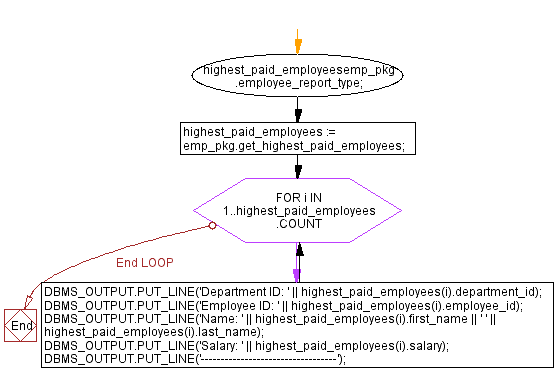Highest paid employees package in PL/SQL
PL/SQL Package: Exercise-15 with Solution
Write a code in PL/SQL that create a package that contains a function to retrieve the highest paid employee in each department.
Sample Solution:
Table: employees
employee_id integer first_name varchar(25) last_name varchar(25) email archar(25) phone_number varchar(15) hire_date date job_id varchar(25) salary integer commission_pct decimal(5,2) manager_id integer department_id integer
PL/SQL Code:
CREATE OR REPLACE PACKAGE emp_pkg IS
TYPE employee_record_type IS RECORD (
department_idemployees.department_id%TYPE,
employee_idemployees.employee_id%TYPE,
first_nameemployees.first_name%TYPE,
last_nameemployees.last_name%TYPE,
salaryemployees.salary%TYPE
);
TYPE employee_report_type IS TABLE OF employee_record_type;
FUNCTION get_highest_paid_employees RETURN employee_report_type;
END emp_pkg;
/
CREATE OR REPLACE PACKAGE BODY emp_pkg IS
FUNCTION get_highest_paid_employees RETURN employee_report_type IS
highest_paid_employeesemployee_report_type;
BEGIN
SELECT department_id, employee_id, first_name, last_name, salary
BULK COLLECT INTO highest_paid_employees
FROM (
SELECT e.department_id, e.employee_id, e.first_name, e.last_name, e.salary,
RANK() OVER (PARTITION BY e.department_id ORDER BY e.salary DESC) AS ranking
FROM employees e
)
WHERE ranking = 1;
RETURN highest_paid_employees;
END get_highest_paid_employees;
END emp_pkg;
/
Sample Output:
Package created. Package Body created
Flowchart:

To execute the package:
DECLARE
highest_paid_employeesemp_pkg.employee_report_type;
BEGIN
highest_paid_employees := emp_pkg.get_highest_paid_employees;
FOR i IN 1..highest_paid_employees.COUNT LOOP
DBMS_OUTPUT.PUT_LINE('Department ID: ' || highest_paid_employees(i).department_id);
DBMS_OUTPUT.PUT_LINE('Employee ID: ' || highest_paid_employees(i).employee_id);
DBMS_OUTPUT.PUT_LINE('Name: ' || highest_paid_employees(i).first_name || ' ' || highest_paid_employees(i).last_name);
DBMS_OUTPUT.PUT_LINE('Salary: ' || highest_paid_employees(i).salary);
DBMS_OUTPUT.PUT_LINE('----------------------------------');
END LOOP;
END;
/
Sample Output:
statement processed. Department ID: 10 Employee ID: 200 Name: Jennifer Whalen Salary: 4400 ---------------------------------- Department ID: 20 Employee ID: 201 Name: Michael Hartstein Salary: 13000 ---------------------------------- Department ID: 30 Employee ID: 114 Name: Den Raphaely Salary: 11000 ---------------------------------- Department ID: 40 Employee ID: 203 Name: Susan Mavris Salary: 6500 ---------------------------------- .....
Flowchart:

Explanation:
The said code in Oracle's PL/SQL package that retrieve highest paid employee in each department and returns the information in a collection of employee records, where each record contains the department_id, employee_id, name, and salary of the highest paid employee in the respective department.
A function get_highest_paid_employees are declared in this package with no input parameters and it returns a collection of employee records representing the highest paid employees in each department.
Inside the function, one local variable highest_paid_employees of type employee_report_type is declared.
The function uses a SQL query with the RANK() window function to rank employees by salary within each department.
The query selects the department_id, employee_id, first_name, last_name, and salary from the "employees" table and assigns a ranking to each employee based on their salary within their respective department.
The outer query filters the results to include only those employees with a ranking of 1, which represents the highest-paid employee in each department.
Finally, the collection highest_paid_employees containing the highest paid employees from each department is returned as the result of the function.
Go to:
PREV : Package to retrieve employees with the same manager in PL/SQL.
NEXT : Average tenure of employees by job category package in PL/SQL.
Have another way to solve this solution? Contribute your code (and comments) through Disqus.
What is the difficulty level of this exercise?
